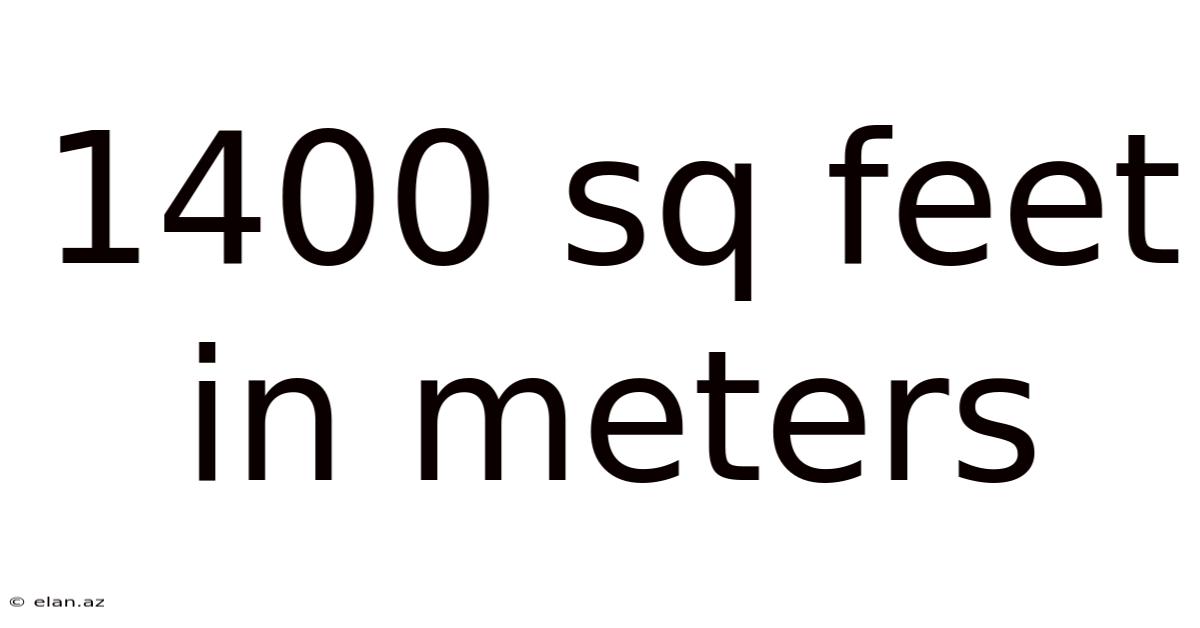1400 Sq Feet In Meters
elan
Sep 11, 2025 · 4 min read

Table of Contents
1400 Square Feet in Meters: A Comprehensive Guide to Unit Conversion and Area Calculation
Understanding different unit systems is crucial in various aspects of life, from construction and real estate to everyday measurements. This comprehensive guide focuses on converting 1400 square feet (sq ft) to square meters (m²), a common conversion needed when dealing with property sizes, floor areas, or any measurement involving area. We'll delve into the conversion process, provide helpful tips, and explore related concepts to solidify your understanding. This guide will empower you to confidently handle similar conversions in the future.
Understanding Square Feet and Square Meters
Before jumping into the conversion, let's briefly revisit the concepts of square feet and square meters. Both are units of area, representing the size of a two-dimensional surface.
-
Square feet (sq ft or ft²): A square foot is the area of a square with sides measuring one foot each. It's part of the imperial system of measurement, commonly used in the United States and some other countries.
-
Square meters (m²): A square meter is the area of a square with sides measuring one meter each. It's part of the metric system (International System of Units or SI), used globally and preferred in most scientific and engineering contexts.
Converting 1400 Square Feet to Square Meters: The Calculation
The conversion from square feet to square meters involves a simple yet important formula:
1 square foot ≈ 0.092903 square meters
Therefore, to convert 1400 square feet to square meters, we multiply the area in square feet by the conversion factor:
1400 sq ft * 0.092903 m²/sq ft ≈ 130.06 m²
Therefore, 1400 square feet is approximately equal to 130.06 square meters.
Beyond the Calculation: Understanding the Conversion Factor
The conversion factor (0.092903) is derived from the relationship between feet and meters. One foot is approximately equal to 0.3048 meters. Since we're dealing with area, which is two-dimensional, we need to square the conversion factor for length:
(0.3048 m/ft)² ≈ 0.092903 m²/ft²
This highlights that converting areas requires squaring the linear conversion factor. This is a crucial point often overlooked, leading to incorrect conversions.
Practical Applications and Examples
Understanding the conversion of 1400 square feet to square meters has various practical applications:
-
Real Estate: When comparing property sizes listed in different unit systems, accurate conversion is essential for fair evaluation and informed decision-making. A house advertised as 1400 sq ft would be roughly equivalent to a 130 m² house.
-
Construction and Engineering: Accurate area calculations are vital in construction planning, material estimation, and project costing. Converting between square feet and square meters ensures consistency and avoids errors.
-
Interior Design: Designing and furnishing a space requires accurate measurements. Converting units ensures proper furniture selection and layout planning, whether you're working with plans in square feet or square meters.
-
Land Surveying: Accurate land area measurements are fundamental in land surveying and property management. The conversion helps in comparing and analyzing land sizes across different regions using different unit systems.
Potential Sources of Error and How to Avoid Them
While the conversion itself is straightforward, potential errors can arise from:
-
Rounding Errors: Using rounded conversion factors can lead to slight inaccuracies, especially when dealing with larger areas. Using the full precision of the conversion factor (0.092903) minimizes these errors.
-
Unit Misunderstandings: Confusing linear measurements (feet or meters) with area measurements (square feet or square meters) is a common mistake. Always double-check the units you're working with.
-
Incorrect Formula Application: Failing to square the linear conversion factor is a frequent error when converting areas. Remember: area conversions involve squaring the length conversion factor.
Frequently Asked Questions (FAQ)
Q1: Is 1400 square feet a large or small house?
A1: Whether 1400 square feet is considered large or small depends on the location and local housing standards. In some areas, it might be considered a comfortable-sized family home, while in others, it might be considered relatively smaller.
Q2: How many bedrooms would a 1400 square foot house typically have?
A2: A 1400 square foot house could typically have 3-4 bedrooms, depending on the layout and the size of other rooms.
Q3: Can I convert square feet to square meters using an online calculator?
A3: Yes, many online calculators are available to perform unit conversions, including square feet to square meters. However, it's always beneficial to understand the underlying principles to avoid relying solely on automated tools.
Q4: What are some other common unit conversions related to area?
A4: Other common area conversions include: * Square yards to square meters * Acres to hectares * Square kilometers to square miles
Conclusion: Mastering Unit Conversions
Converting 1400 square feet to square meters, as demonstrated, is a relatively simple process. However, understanding the underlying principles—the relationship between linear and area measurements and the importance of using the correct conversion factor—is crucial for accurate and reliable conversions. Mastering these concepts empowers you to confidently handle various area calculations in various fields. Remember to always double-check your work and use the full precision of the conversion factor to minimize errors. This guide provides a solid foundation for tackling similar conversions and confidently navigating the world of measurements.
Latest Posts
Latest Posts
-
5 Letter Words Ending One
Sep 11, 2025
-
Functional Groups For Organic Chemistry
Sep 11, 2025
-
Inequalities On A Number Line
Sep 11, 2025
-
Lcm Of 70 And 273
Sep 11, 2025
-
Nice Words Start With E
Sep 11, 2025
Related Post
Thank you for visiting our website which covers about 1400 Sq Feet In Meters . We hope the information provided has been useful to you. Feel free to contact us if you have any questions or need further assistance. See you next time and don't miss to bookmark.